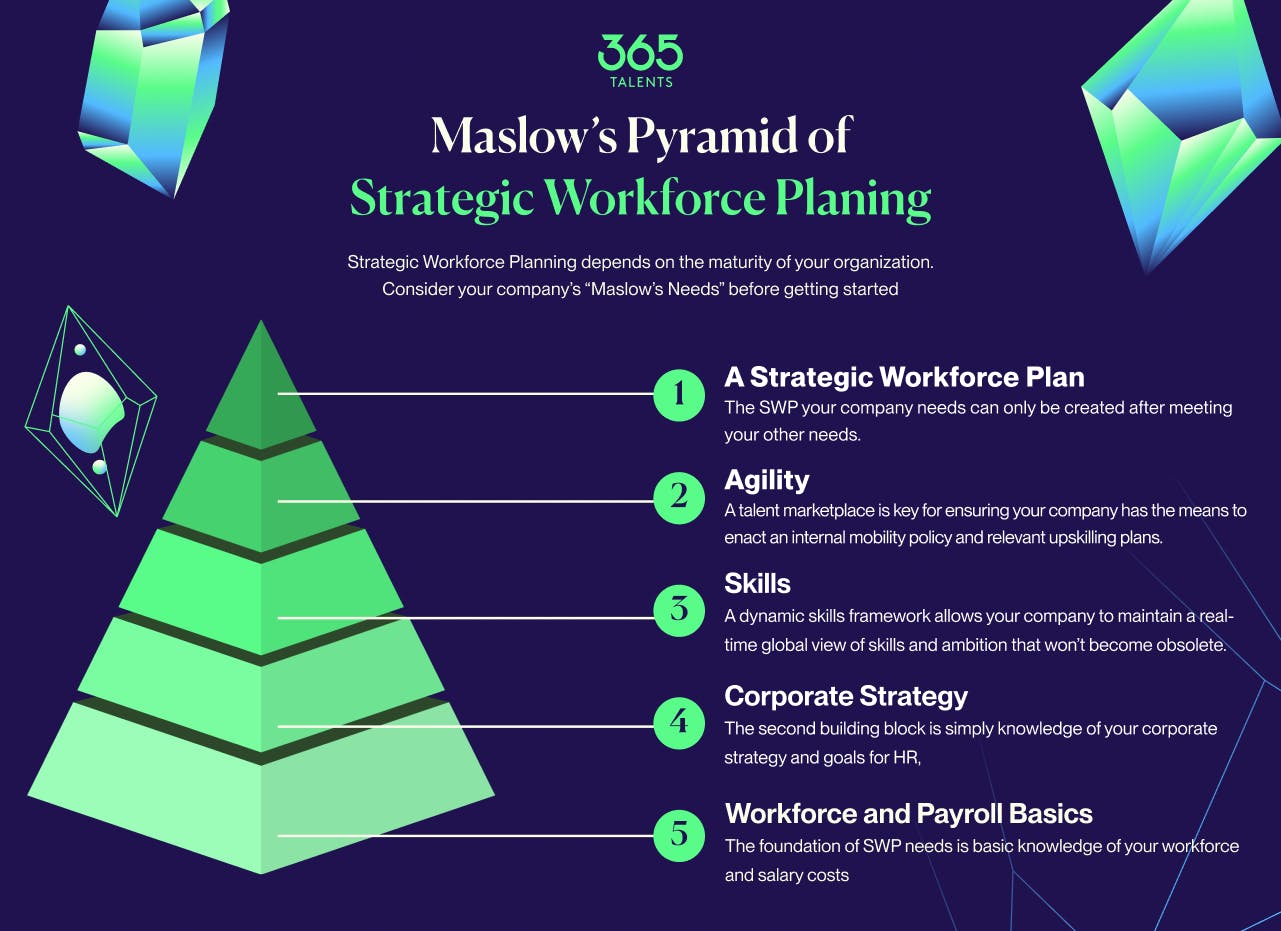6 stages of strategic workforce planning

The need to identify the skills of tomorrow and the management of uncertainty are key issues for human resource departments, and it is here that strategic workforce planning (also known as “strategic management of human capital,” but we prefer not to call our people “capital”) comes most strongly into play.
Strategic workforce planning (SWP) allows you to anticipate, plan and ensure that the right people are in the right place at the right time. It’s a major asset in leveraging HR for solving your company's strategic challenges.
In this guide, we will go into detail to give you ways to apply SWP to your structure. We'll cover:
- The definition and objective(s) of strategic workforce planning
- Why is SWP crucial for companies today
- The differences between SWP and other HR approaches
- The 6 stages of a successful SWP approach
- And just for fun, Maslow’s Pyramid of HR Needs for strategic workforce planning
What is strategic workforce planning?
Let’s start with a concrete definition of SWP: “Having the right number of people, with the right skills, in the right place at the right time, in order to meet the strategic objectives of the organization.”
The approach itself is based on four criteria:
1. Size
The size criterion concerns the number of job offers: too many offers and the whole company is slowed down. In contrast, offering few offers comes down to understaffing. The objective is to have (1) little friction, (2) no vacancies and (3) no overstaffing.
2. Form
Form means knowledge of the skills required to meet current and future needs. This criterion takes into account key skills and replacement management.
3. Cost
Achieving the “right cost” requires understanding the balance of employee costs. To achieve this, there are two factors: cost efficiency and reasonable cost.
4. Agility
Agility is demonstrated by a workforce that is flexible and knows how to adapt to changing market needs.
The golden rules to be followed:
- Agility
- Resilience
- Flexibility
To make a SWP strategy effective and sustainable, there must be a balance between all these factors.
Why is strategic workforce planning important?
Strategic workforce planning aims to address future issues related to employee management and is becoming increasingly crucial for several reasons:
- Cost reduction: Companies are forced to adapt to competition quickly and intelligently, or risk disappearing. With this in mind, outsourcing is on average more expensive but not necessarily more productive to meet strategic needs.
- Demographic changes: A dynamic workforce close to retirement age poses other problems, such as training challenges, the lack of skills sought and probably mass departures.
- Talent management: Dynamic talents in your company are your first competitive advantage. It’s essential to take good care of them!
- Need for flexibility: Speed and disruption are essential ingredients for implementing an innovation approach. To grow and remain competitive, they must be an integral part of the business. We can also see the importance of this component in the constant increase in income generated by new market players. The message is innovate or disappear.
How is strategic workforce planning different than… ?
Job and Skills Management and Forecasting (GPEC)
In France, Jobs and Skills Management and Forecasting (GPEC) provides a diagnosis of the jobs and skills present within the company. Subsequently, HR measures are taken to support their development. Jobs and Skills Management and Forecasting works with your employees on a daily basis. Strategic Workforce Planning, on the other hand, is not connected to the individual development of employees and the purpose of SWP is to establish a strategy of long-term anticipation.
People Analytics
The people analytics approach is based on data mining to support talent management. The purpose is to continually analyze the relationships between what motivates employees and the company’s results. In contrast, SWP takes a longer term vision and specifically targets strategic requirements. People Analytics is therefore a tool on which HR can rely to implement SWP.
Although People Analytics and Jobs and Skills Management and Forecasting should not be confused with Strategic Workforce Planning, they are complementary practices to support HR needs.
6 stages of a successful SWP approach
Last year, Neelie Verlinden, Content Creator and Co-Founder of the AIHR Digital platform, shared an action plan to effectively steer SWP.
Here is our version:
1. Consider your company’s strategic objectives
Taking into account the alignment of the company’s objectives with the project is the first key factor for success. In this way you can clearly demonstrate the relevance of your approach, involve all stakeholders from the beginning and avoid obstacles in future steps.
Ask yourself:
– What does my organization want to do?
– What are my company’s short-, medium- and long-term objectives?
– What skills do I need to achieve these goals?
2. Analyze your current workforce
The need for SWP comes directly from your employees. You must have an updated overview of all the skills in motion in the company. To succeed in this stage, skills mapping, People Analytics and Jobs and Skills Management and Forecasting are valuable tools to draw on. For example, you can build on your employees’ demographic data, their level of seniority and their ambitions to further your plan.
There are two ways to consider the analysis of your workforce, in terms of quality and quantity.
- Quality: Assess employees on their current performance and future potential.
- Quantity: Quantify your workforce then segment it, taking into account recruitment, turnover and internal mobility.
Ask yourself:
– What is the current diagnosis of my workforce in terms of quality?
– What skills are already present in the company?
– Who are the most high performing employees in the company?
– What is their potential?
3. Identify the future need for skills
Now that you have a clear vision of skills mapping for your employees and their needs, you can start to think about the next step: identifying the skills you will need in the future.
Ask yourself:
– What skills are missing in my company today?
– What skills should be provided in the medium and long term?
4. Create multiple scenarios
Identifying skill needs in line with business objectives does not guarantee that everything will go well. You cannot predict the future and it is for this reason that weighing up several scenarios will help you to understand the uncertainty.
Take, for example, the COVID-19 pandemic. Lockdowns around the globe opened the eyes of many companies who were previously reluctant to implement regular work from home policies. They were forced to accept that this practice enabled businesses to keep running amidst health restrictions. With the SWP applied to this example, you can already anticipate several types of impacts of working from home on your structure:
- The impact on management methods: Managers must learn to unite, motivate and involve employees remotely. To do this, they will need to be supported and trained so that they can apply these new management methods.
- The impact on soft skills: How can soft skills remain impactful when they can no longer be developed in person? What is the risk for work organization?
- The impact on demotivation: It is undeniable that some employees are reluctant to return to the office, so how can we limit this type of situation occurring? What measures need to be introduced for demotivated employees?
- The impact on informal relations: informal discussions between employees contribute greatly to innovation and creativity in the company, which is how ideas emerge. How can we preserve this dynamic?
Once the various impacts have been identified, the aim is to determine their influence on the company. Always referring to the COVID example, if no action is taken to limit the impact of remote work, what is the risk for the company in terms of turnover? Which department will be most affected?
Imagining several scenarios means taking into account unexpected events.
5. Use external expertise
Strategic Workforce Planning requires different sorts of expertise, especially to identify skills missing in the company. To help you, get the support of tools and partner companies who can bring value to all stages of the project.
For example, an expert in Strategic Workforce Planning can provide key methodology to carry out relevant scenarios and a solution that provides a dynamic skills framework with a real-time view of company talent will help you analyze your workforce effectively.
SWP is clearly not an easy task, especially when agility and digital transformation are not part of the corporate culture. A partner solution can be useful for all or part of the project and help you keep to your schedule and achieve your objectives.
As part of the impact of working from home, an SWP expert will be able to support you in implementing HR solutions to tackle your problem:
- Train managers in new development methods
- Promote soft skills with new working methods
- Take corrective measures for reluctant employees such as a charter to encourage them to return to the workplace.
- Implement tools that maintain informal communication.
6. Analyze, advise and adapt
Once the project has been launched, your mission is still not complete. SWP is based on principles of agility and must therefore be managed using the famous “test and learn” methodology. In other words, instead of implementing a set-in-stone process, you learn continuously and adapt your approach.
To carry out an approach in line with an ever-changing environment, adopt solutions that are easily integrated into your existing tools and allow you to build on all the data. You can refer to these indicators to adapt your Strategic Workforce Planning and always keep one step ahead!
Maslow’s pyramid of needs for strategic workforce planning
Are you familiar with Maslow’s Pyramid of Needs? In 1943, American psychologist Abraham Maslow published an article entitled “A Theory of Motivation.” This publication disrupted the world of work by prioritizing human needs on five levels:
- Physiological needs: biological and physical needs such as breathing, sleeping, eating, drinking, etc.
- Safety needs: needs related to the safety of the body, employment, resources, morality, etc.
- Need for belonging: friendship, family and intimacy, etc.
- Need for respect: self-esteem, trust, success, respect for others
- Need for self-fulfillment: the need to achieve, to highlight one’s potential and to flourish.
The choice to model this information in pyramid form is important, since Maslow argued that we start with physiological needs and move towards the final stage: self-fulfillment. It is a process.
Understanding your SWP needs
To help you understand your organization even better, we’ve applied Maslow’s model to strategic workforce planning.
- Physiological needs = Workforce and payroll. The first essential building block of your SWP is the need to know your workforce and payroll costs well because they are also part of your SWP equation.
- Safety needs = Corporate strategy. The second building block is part of the SWP's fundamentals: knowledge of the corporate strategy and a strategic plan to be operationalized in terms of HR.
- Belonging = Internal skills. It is from the third level that things get tougher for most companies and equates to real knowledge of all the internal skills of each employee. Often, companies use fixed frames of reference that rarely reflect reality since they are rapidly obsolete.
- Respect = Internal agility capabilities. This is the fact of whether the company has the means to implement a good internal mobility policy and relevant upskilling plans. The best tool for this is what is called a Talent Marketplace to build on internal skills.
- Self-fulfillment = Strategic workforce plan. Finally, at the top of the pyramid, if your company has all of the above, it can successfully roll out strategic workforce planning.

SWP must be based on all these prerequisites to be effectively implemented. Indeed, a company must understand its level of maturity before embarking on strategic workforce planning.


Ready to chart a new course for your people at work?
Book a demo today to learn about the tools 365Talents provides for strategic workforce planning.

Uncover more HR insights









